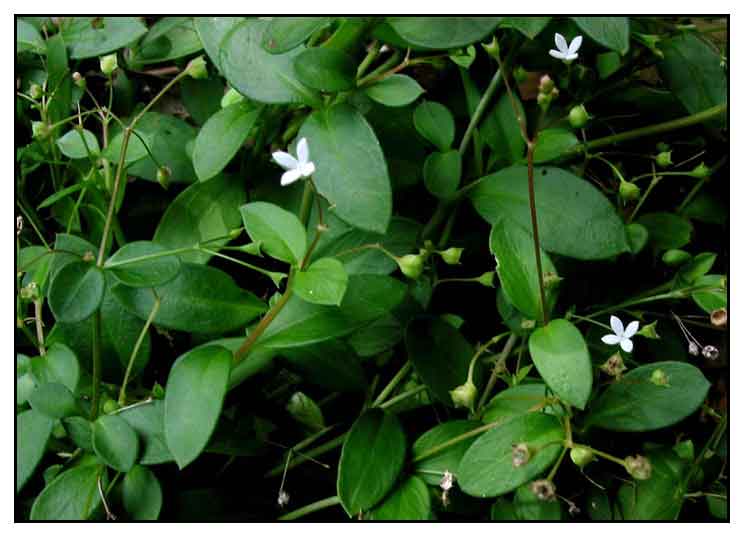
Family • Rubiaceae
Pisek
Leptopetalum biflorum (L.) Neupane & N.Wikstr.
TWO FLOWER MILLE GRAINES
Shuang hua er cao
| Scientific names | Common names |
| Gonotheca biflora (L.) Masam. | Dalumpang (Sub.) |
| Hedyotis alsinifolia Zipp. ex Span. | Kaddok-na-kalinga (Ibn.) |
| Hedyotis biflora (L.) Lam. | Palarapdap (S. L. Bis.) |
| Hedyotis biflora var. uniflora Kurz | Pisek (Iv.) |
| Hedyotis blumeana Steud. | Coastal vine weed (Engl.) |
| Hedyotis burmanniana Schult. & Schult.f. | Two flower mille graines (Engl.) |
| Hedyotis debilis Roem. & Schult. | |
| Hedyotis dichotoma Cav. | |
| Hedyotis gracilis DC. | |
| Hedyotis hermanniana R.M.Dutta | |
| Hedyotis media Cav. | |
| Hedyotis multiflora Cav. | |
| Hedyotis paniculata Rottler ex Wight & Arn. | |
| Hedyotis ramossisima Blume | |
| Leptopetalum biflorum (L.) Neupane & N.Wikstr. | |
| Oldenlandia biflora Linn. | |
| Oldenlandia brachypoda Zoll. ex Miq. | |
| Oldenlandia dichotoma (Cav.) Willd. ex Cham. & Schltdl. | |
| Oldenlandia multiflora (Cav.) DC. | |
| Oldenlandia radicans Roxb. ex Wight & Arn. | |
| Thecagonum biflorum (L.) Babu | |
| Oldenlandia biflora L. is a synonym of Leptopetalum biflorum (L.) Neupane & N.Wikstr. | |
| Leptopetalum biflorum is an accepted soecies. KEW: Plants of the World Online | |
| Other vernacular names |
| CHINESE: Shuang hua er cao |
| COOK ISLANDS: Pokea teatea. |
| INDIA: Damanpapra. |
| JAPANESE: Sonare mugura, Motukuwa. |
Updated May 2024 / December 2018 / August 2016
![]()
 |
PHOTOS / ILLUSTRATIONS |
| IMAGE SOURCE: Oldenlandia biflora / Habit of flowering plant / Copyright © 2011 by Leonardo L. Co (contact: pieter.pelser@canterbury.ac.nz) [ref. DOL26922] / Non-commercial use ; Click on image or link to go to source page / PhytoImages.siu.edu / |
| OTHER IMAGE SOURCE: Leptopetalum biflorum / Leaves and flowers / Copyright © Dr N Sasidharan: Keral Forest Research Inst., Peechi /Click on image or link to go to source page / eFloraOfIndia |
Additional
Sources and Suggested Readings |
α•(5) |
DOI: It is not uncommon for links on studies/sources to change. Copying and pasting the information on the search window or using the DOI (if available) will often redirect to the new link page. (Citing and Using a (DOI) Digital Object Identifier) |
| List of Understudied Philippine Medicinal Plants |
| New plant names needed The compilation now numbers over 1,300 medicinal plants. While I believe there are hundreds more that can be added to the collection, they are becoming more difficult to find. If you have a plant to suggest for inclusion, native or introduced, please email the info: scientific name (most helpful), local plant name (if known), any known folkloric medicinal use, and, if possible, a photo. Your help will be greatly appreciated. |
α•(5) |
 |



